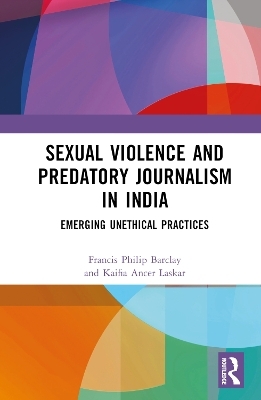
Sexual Violence and Predatory Journalism in India
Routledge (Verlag)
978-1-032-58695-3 (ISBN)
- Noch nicht erschienen (ca. Februar 2025)
- Versandkostenfrei innerhalb Deutschlands
- Auch auf Rechnung
- Verfügbarkeit in der Filiale vor Ort prüfen
- Artikel merken
This book conceptualises and analyses predatory practices that commodify sexual crimes against women, examining how it is facilitated and motivated by online spaces and social media channels and how it can often result in further harm to victims and their families. It argues for editorial intervention, more regulation, policy measures and legal frameworks that will help build a sensitive and ethical media landscape and rebuild public trust. Key issues examined include sexism, sensationalism, invasion of privacy, victim blaming, media trials, media manipulation of information, armchair reporting, explicit sexual imagery, the usage of unreliable sources and a lack of responsibility and accountability.
Providing a comprehensive analysis of the issue and offering a framework for ethical practice, Sexual Violence and Predatory Journalism in India will be essential reading for scholars and students of media and cultural studies, journalism and sociology interested in the intersection of media and crime in India and its associated ethical challenges.
Francis Philip Barclay is Assistant Professor of Media and Communication at the Central University of Tamil Nadu, India. He is founding editor of the Journal of Media and Communication and co-editor of Social Media in India: Regulatory Needs, Issues and Challenges (2022) and Gender and Popular Visual Culture in India: ‘Benevolent’ Sexism and Disguised Discrimination (Routledge, 2023). Kaifia Ancer Laskar is Assistant Professor of Journalism and Mass Communication at Aliah University, India. She is co-editor of Gender and Popular Visual Culture in India: ‘Benevolent’ Sexism and Disguised Discrimination (Routledge, 2023).
Foreword Introduction: Foregrounding Predatory Journalism in Reporting Sexual Violence Part I: Introduction 1. What Makes Sensational Sexual Crime Stories? Topical Bias and News Prioritisation 2. Predatory Journalism: Conceptualisation Part II: Unmasking the Predator 3. Headline Horrors: Losing Sense for Sexist Sensationalism 4. Prejudicial Reporting and Media Trials: Case Studies 5. Eroticism and Exhibition: Editorial Exploits in Rape Reporting 6. Churnalism: How ‘Spiced-up’ Sexual Crime News Stories Are Cooked Up in Minutes Part III: Taming the Beast 7. The Social Dilemma: Rise and Impact of Social Media News Channels 8. Predatory Journalism: Consolidation, Criticism and Consequences 9. The Way Forward: Building a Sensitive and Ethical Media Landscape
| Erscheint lt. Verlag | 18.2.2025 |
|---|---|
| Zusatzinfo | 17 Tables, black and white; 5 Line drawings, black and white; 5 Illustrations, black and white |
| Verlagsort | London |
| Sprache | englisch |
| Maße | 156 x 234 mm |
| Themenwelt | Sozialwissenschaften ► Kommunikation / Medien ► Journalistik |
| Sozialwissenschaften ► Soziologie | |
| ISBN-10 | 1-032-58695-8 / 1032586958 |
| ISBN-13 | 978-1-032-58695-3 / 9781032586953 |
| Zustand | Neuware |
| Haben Sie eine Frage zum Produkt? |
aus dem Bereich


